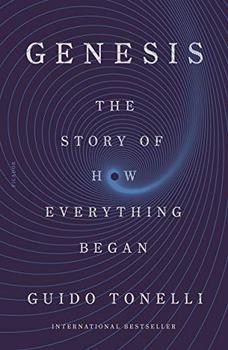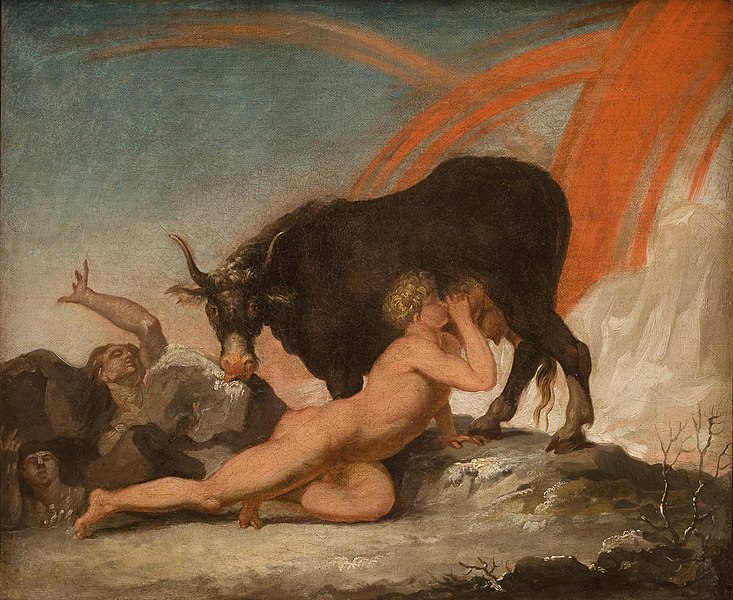Summary | Excerpt | Reviews | Beyond the Book | Read-Alikes | Genres & Themes | Author Bio

The Story of How Everything Began
by Guido TonelliThis article relates to Genesis
 Woven into Guido Tonelli's Genesis are origin myths from different cultures and religions throughout history. He frames his work using the first book of the Hebrew Bible and often brings up creation myths from around the world. So what are these myths, and what do they have in common?
Woven into Guido Tonelli's Genesis are origin myths from different cultures and religions throughout history. He frames his work using the first book of the Hebrew Bible and often brings up creation myths from around the world. So what are these myths, and what do they have in common?
In the creation story found in the Hebrew Bible and Christian Old Testament, God created the world in seven days. On the first day was light; on the second, the sky. On the third day, He created the land, seas, plants and trees. On the fourth day came the sun and the moon. On the fifth day were the living creatures that swim and fly. On the sixth day, God created land animals and humans; on the seventh, He rested.
The Norse myth of creation is quite different from the Hebrew one, but not entirely dissimilar. It begins with Ymir, a frost giant formed where ice and fire met. Ymir, neither male nor female, had a companion, a cow named Audhumla. The cow licked at a block of ice and from this ice was born Buri, ancestor of the gods. Ymir gave birth to other giants, and Buri had a son, Bor. Bor married the giant Bestla, and they had three sons: Odin, Vili and Ve. These three sons killed Ymir, and used the giant's body to create the world. Ymir's flesh became the soil. Their bones were used to make mountains. Ymir's teeth became rocks and stones. The rivers and oceans were made from Ymir's blood. Ymir's skull formed the sky and their brains became the clouds.
The creation myth of Shinto, the primary religion of Japan, is in synch with some elements of these other myths while offering its own distinct story. In the beginning was the bridge to heaven — Ama-no-hashidate — and on that bridge stood the two gods Izanami and Izanagi, who used a jewel-encrusted spear to stir the ocean below and form the island of Onogoro-shima. The two gods married and gave birth to the other islands of Japan, as well as more gods and natural formations.
According to Greek mythology, from Chaos came Gaia (Earth) and Uranus (sky). Their 12 children were the Titans, the most important of which were Rhea and Kronos, who married and gave birth to the gods. A prophecy stated that Kronos would be killed by one of his children, and so he swallowed each of them as soon as they were born. However, Rhea tricked her husband and disguised a rock as the baby Zeus, hiding the real child in a cave. When he came of age, Zeus freed his brothers and sisters from his father's belly, and so began a war between the gods and the Titans. After winning the war, Zeus became the king of heaven. His brothers Poseidon and Hades became lord of the sea and of the underworld respectively. Prometheus, a Titan who abstained from the war, created humans and gifted them fire.
What all of these creation myths have in common, regardless of where they are from, is that a cosmic being or beings create the Earth and everything on it. These beings tend to have skills and knowledge far beyond our own, and are generally born from chaos or nothingness. Many ideas overlap when it comes to mythology and science, with one the most prominent being a look to the sky and the stars for answers as to the origins of our world and ourselves.
Ymer dier koen Ødhumbla (Ymir Suckling the Cow Audhumla) by Nicolai Abildgaard (circa 1777), from Statens Museum for Kunst
Filed under Cultural Curiosities
![]() This "beyond the book article" relates to Genesis. It originally ran in May 2021 and has been updated for the
April 2022 paperback edition.
Go to magazine.
This "beyond the book article" relates to Genesis. It originally ran in May 2021 and has been updated for the
April 2022 paperback edition.
Go to magazine.
Information is the currency of democracy
Click Here to find out who said this, as well as discovering other famous literary quotes!
Your guide toexceptional books
BookBrowse seeks out and recommends the best in contemporary fiction and nonfiction—books that not only engage and entertain but also deepen our understanding of ourselves and the world around us.